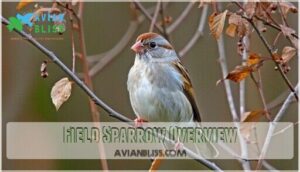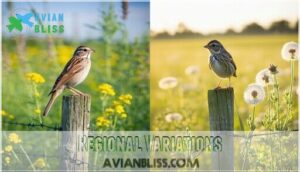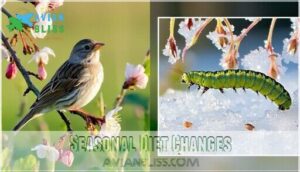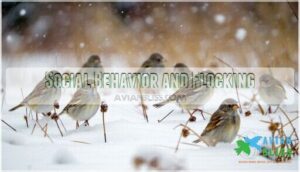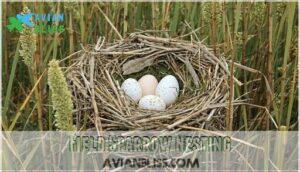This site is supported by our readers. We may earn a commission, at no cost to you, if you purchase through links.

These small songbirds thrive in brushy fields, meadows, and forest edges across eastern and central North America.
They’re ground foragers, hunting seeds and insects while staying close to cover.
Their signature song sounds like a bouncing ball—starting slow and accelerating into a rapid trill.
Field sparrows prefer early-successional habitats where tall grasses meet scattered shrubs.
Though they’ve declined in suburban areas, they remain common in rural settings.
Their unassuming brown plumage might fool you, but that pink bill gives them away every time.
Table Of Contents
- Key Takeaways
- Field Sparrow Overview
- Habitat and Range
- Behavior and Diet
- Field Sparrow Nesting
- Conservation and Threats
- Frequently Asked Questions (FAQs)
- What is the difference between a field sparrow and an American tree sparrow?
- Are Field Sparrows endangered?
- Where does the field sparrow live?
- What is the difference between a field sparrow and a chipping sparrow?
- What is a field sparrow?
- What is the difference between a Field Sparrow and an American tree sparrow?
- Are Field Sparrows migratory?
- What do field sparrow eggs look like?
- What does a field sparrow look like?
- What does a field sparrow sound like?
- Conclusion
Key Takeaways
- You’ll identify field sparrows by their distinctive pink bills and bold white eye rings, which set them apart from other small brown birds in brushy habitats.
- You’ll find these sparrows in early-successional areas like overgrown fields, woodland edges, and shrubby pastures rather than wide-open grasslands despite their name.
- You’ll hear their signature "bouncing ball" song that starts slow and accelerates into a rapid trill, making them easier to locate before you spot them.
- You’ll need to support conservation efforts since field sparrow populations have declined by 60% since 1966 due to habitat loss and climate change impacts.
Field Sparrow Overview
You’ll spot Field Sparrows by their distinctive pink bills and bold white eye rings that make them stand out from other small brown birds.
These compact sparrows measure just 4.7 to 5.9 inches long and prefer brushy habitats where their rusty caps and pale gray faces help experienced birders distinguish them from similar species.
Physical Characteristics
Spotting a Field Sparrow starts with recognizing its baby-faced appearance and warm plumage details.
You’ll notice three key features that set this bird apart:
- Pink conical bill – distinctive coloration unlike other sparrows
- Bold white eye ring – creates that innocent, rounded look
- Rusty crown and eye stripe – contrasts beautifully with gray face
The unmarked, buffy breast and relatively long tail shape complete this charming sparrow’s profile.
These birds thrive in brushy field habitats.
Size and Morphology
When measuring Field Sparrow size, you’ll notice their compact build ranges from 4.7 to 5.9 inches in length with body proportions smaller than Song Sparrows but larger than chickadees.
Their conical bills are distinctly pink, while wing dimensions span nearly 8 inches and their notched tail shape appears relatively long for their petite frame, creating balanced plumage details, with a compact build.
Color Morphs and Variations
Field Sparrows display two distinct color morphs that’ll help you nail your bird identification.
The gray morph shows subdued tones, while the rufous morph exhibits warmer, rust-colored plumage across the crown and flanks.
Regional plumage variations occur naturally, with western populations favoring grayer tones and eastern birds showing more vibrant colors.
Their preferred breeding habitat includes brushy fields.
- Gray morph features pale upperparts with minimal warm coloration
- Rufous morph displays intense chestnut tones on crown and eyeline
- Regional plumage differences create identification challenges across ranges
- Genetic basis for color variation remains consistent in both sexes
- Hybridization between morphs produces intermediate plumage patterns
The genetic basis for color variation is an important aspect to consider, and the fact that it remains consistent in both sexes is noteworthy.
The identification challenges posed by regional plumage differences are significant, especially when trying to distinguish between the gray and rufous morphs.
Habitat and Range
You’ll find Field Sparrows in brushy, early-successional habitats rather than wide-open grasslands despite their name.
These birds prefer overgrown fields, shrubby pastures, woodland edges, and abandoned farmland where scattered bushes provide essential cover and nesting sites.
Preferred Habitats
You’ll find field sparrows thriving in brushy, early-successional habitats rather than wide-open grasslands.
Their shrubland dependence leads them to overgrown meadows, woodland edges, and abandoned farmland with scattered bushes.
These sparrows show strong habitat specificity, avoiding dense forests and heavily developed areas while preferring regional habitat variations that include shrubby pastures and hedgerows for ideal foraging and nesting opportunities.
Regional Variations
Eastern populations favor old fields and woodland edges, while western populations use mixed-grass prairies across the Great Plains.
These habitat adaptations reflect genetic differences between regions.
Song variations also occur – northeastern field sparrows produce faster, higher-pitched trills than their southern counterparts.
Nesting preferences shift from shrubby meadows in the Southeast to prairie grasslands westward.
These variations highlight how habitat fragmentation isolates bird populations, reflecting the impact of habitat fragmentation and regional adaptations on their behavior.
Migration Patterns
You’ll find field sparrow migration follows predictable patterns, with northern populations becoming partial migrants while southern birds stay put year-round.
Climate influence drives their seasonal movements, creating distinct migration routes to wintering grounds.
- Migration Triggers: Shortening daylight and dropping temperatures signal departure time
- Wintering Grounds: Southern U.S. and northern Mexico provide suitable habitat
- Stopover Ecology: Birds refuel at brushy edges during long journeys
- Range Maps: Show clear north-south movement patterns across eastern regions
Behavior and Diet
Field sparrows show fascinating feeding behaviors that change dramatically with the seasons.
You’ll find these resourceful birds using specialized techniques to gather everything from tiny grass seeds to protein-rich insects depending on what their bodies need most, which includes utilizing protein-rich insects.
Foraging Techniques
You’ll spot field sparrows using two main foraging techniques that showcase their feeding behavior adaptability.
Ground foraging dominates their routine as they hop through leaf litter, scratching and pecking for seeds and insects.
They’ll also engage in perch hunting, briefly scanning from grass stems before snatching prey.
Their seed specialization centers on smaller grass varieties, while insect consumption increases during breeding season for protein needs.
They often consume specific field sparrow seed depending on availability.
Seasonal Diet Changes
Throughout the year, field sparrow diet shifts dramatically based on seasonal availability.
Winter seeds dominate cold months, comprising 90% of intake as insects become scarce.
During breeding season, dietary needs flip—summer insects and caterpillars provide essential protein for nestling food.
Adults boost insect consumption by 700% compared to winter, targeting nutrient-rich prey for growing young.
Social Behavior and Flocking
Field sparrows show interesting social patterns throughout the year.
You’ll observe them foraging alone or with their mate during breeding season, displaying minimal aggression and clear communication signals.
In winter, they join loose mixed flocks with other sparrow species, creating simple flock dynamics without rigid social hierarchy.
Their mating behavior involves territorial displays, while their bird behavior shifts from solitary foraging to cooperative feeding in groups.
This cooperative feeding helps with enhanced predator protection.
Field Sparrow Nesting
You’ll discover Field Sparrows build their nests low to the ground in dense shrubs and grasses, creating cup-shaped structures from fine materials.
These secretive birds typically raise two to three broods per season, with females handling most incubation duties while both parents feed the growing nestlings.
Nest Construction and Materials
Building their homes requires careful planning and resourcefulness. Female Field Sparrows select concealed nesting sites in dense shrubs or tall grasses, typically 1-4 feet above ground.
Their nest building stages involve weaving together available materials while employing natural camouflage techniques to protect against predators.
Key nesting materials include:
- Coarse grass stems – Foundation structure for outer nest walls
- Fine rootlets and hair – Soft inner lining for eggs and chicks
- Dead leaves and bark strips – Natural camouflage and insulation layers
- Plant fibers and moss – Binding materials to secure nest structure
- Feathers when available – Additional warmth and comfort for nestlings
The material gathering process spans several days, with females making multiple trips to collect suitable items. Some birds may even utilize pre-made nesting materials to expedite construction.
Nest reuse frequency remains low, as most pairs construct new nests for each brood rather than renovating previous structures.
Egg Description and Incubation
You’ll find three to four pale blue or bluish-white eggs with brown speckles in each clutch.
The female handles all incubation duties for twelve to thirteen days, rarely leaving her nest except for brief feeding breaks.
Egg coloration provides camouflage against predators, while consistent incubation guarantees successful hatching rates around eighty percent in undisturbed nests, which is a result of consistent incubation.
Fledging and Nestling Care
After nestlings hatch, you’ll observe intensive parental roles as both adults deliver insects every few minutes throughout daylight hours.
This high feeding frequency supports rapid fledgling development, with young leaving the nest after 7-8 days.
However, nestling mortality remains significant due to predator influence and weather.
Parents clean the nest to prevent parasite buildup.
Parents continue feeding fledglings for another week post-departure.
Conservation and Threats
Field Sparrows face serious conservation challenges that you should know about if you care about preserving this species.
These charming sparrows need our help before it’s too late to save them.
Their populations have declined dramatically over recent decades due to habitat loss, climate change, and agricultural practices that eliminate the brushy fields they need to survive.
Population Trends and Decline
You’ll find field sparrow populations have plummeted dramatically over recent decades.
Bird population monitoring programs reveal alarming decline causes that paint a concerning picture for this species’ future.
- North American surveys show 60% population decline since 1966, with annual losses of 2.3%
- Regional differences vary widely – Massachusetts faces 6.1% yearly drops while some areas remain stable
- Conservation efforts focus on habitat restoration through prescribed burns and shrubland management
- Future projections suggest another 50% reduction within 20-25 years without intervention
Climate Change Impacts
Climate change is reshaping where and when you’ll spot Field Sparrows.
Range Shifts push populations northward at 1.2 kilometers yearly, while southern breeding areas contract by 15%.
Extreme Weather events reduce nest success by 11% during spring heatwaves.
Food Availability mismatches occur in 20% of nests as insects peak earlier.
Rising temperatures also contribute to these shifts.
Habitat Degradation from altered precipitation patterns decreases ideal habitat by 28% by 2050, threatening bird populations substantially due to Climate Change and Habitat Degradation.
Habitat Loss and Fragmentation
Field Sparrows face mounting pressure from habitat loss and fragmentation across their range.
Development converts early-successional fields into suburbs, while agricultural intensification eliminates shrubby hedgerows.
These grassland birds need patch size and connectivity – habitat corridors linking shrublands boost survival.
Edge effects from fragmentation increase predation risks.
Conservation strategies focus on managing abandoned farmland and restoring bird conservation areas through prescribed burns and selective clearing.
Frequently Asked Questions (FAQs)
What is the difference between a field sparrow and an American tree sparrow?
You’ll spot key differences in their bills and eye markings.
Field sparrows have pink bills and white eye rings, while American tree sparrows sport yellow-orange bills with dark tips and rusty eye lines instead of rings.
Are Field Sparrows endangered?
Imagine a bird whose population has dropped by up to 90% in some areas.
You won’t find Field Sparrows officially endangered, but their numbers are falling fast due to habitat loss and climate change pressures.
Keep watchful.
Where does the field sparrow live?
You’ll find these small sparrows across eastern and central United States, thriving in brushy fields, overgrown meadows, woodland edges, and shrubby pastures rather than wide-open spaces.
What is the difference between a field sparrow and a chipping sparrow?
Unlike brushy birds who sport pink bills and white eye rings, chipping sparrows showcase chestnut caps paired with distinctive black eyeline stripes.
Unlike field sparrows’ white eyerings for clear identification, chipping sparrows can be distinguished by their unique characteristics.
What is a field sparrow?
You’ll recognize this small sparrow by its pink bill, white eye ring, and rusty-brown cap. Field sparrows prefer brushy habitats and overgrown fields, feeding primarily on grass seeds and insects.
What is the difference between a Field Sparrow and an American tree sparrow?
You’ll spot key differences in their bills and markings.
Field Sparrows have pink bills and white eye rings, while American Tree Sparrows sport dark upper bills with yellow lower portions and dark chest spots.
Are Field Sparrows migratory?
Field Sparrows are partially migratory birds. You’ll find northern populations migrating south to warmer regions during winter, while southern populations often stay year-round residents in their territories.
What do field sparrow eggs look like?
Like precious pearls nestled in nature’s jewelry box, you’ll discover field sparrow eggs are pale bluish-white or greenish-white with delicate brown speckles scattered across their smooth surfaces, creating tiny masterpieces.
What does a field sparrow look like?
You’ll recognize this small songbird by its pink bill, white eye ring, and rusty cap.
It has warm brown upperparts with subtle streaks, pale underparts, and measures about five inches long.
What does a field sparrow sound like?
Contrary to popular belief that sparrows all sound alike, you’ll discover this species produces a distinctive musical pattern.
Field sparrows sing accelerating whistles building to rapid trills, lasting about four seconds with a "bouncing ball" quality.
Conclusion
Mastering field sparrow identification becomes much easier once you’ve learned their key features and behaviors.
You’ll spot these charming birds in brushy habitats where they forage quietly near cover, always ready to dart into dense vegetation when threatened.
Their pink bills and distinctive bouncing-ball songs make reliable identification markers throughout their range.
Remember that field sparrows prefer early-successional areas with mixed grasses and shrubs.
With practice, you’ll confidently distinguish these lovely songbirds from similar species during your next birding adventure.

